Tai chi or tai chi chuan is an ancient Chinese martial art and its practice has many benefits for the body and mind. In addition to giving a sense of peace and improving concentration, the tai chi also improves the elasticity of the body, balance and strengthen muscle tone.
Furthermore, the constant and conscious practice of the tai chi chuan has a therapeutic purpose because it improves health and makes the body more resistant to disease. In fact, it is for this reason that the Chinese government has been encouraging and spreading the practice since the 50s.
In fact, since 1999, the world tai chi day, the World Tai Chi Day, has been recognized by the World Health Organization (WHO) and the UN. It is celebrated on the last Saturday of April.
Tai chi combines the Chinese Taoist theories of the opposites Yin and Yang and the five elements. Often described as a moving meditation, it is much more than one energy gymnastics, is a martial art and any movement can also be used for self defense.
La movement sequence is precise, controlled and it looks like a dance. Also, in practice, slow movements stress muscles that you don't usually use in other classic sports, such as the intercostal muscles and the diaphragm.
A study conducted byTaiwan University showed that 30 minutes of tai chi a day for 6 months, increase muscle strength in people between the ages of 50 and 60.
Furthermore, it is a highly recommended discipline for Older people and to whom has bone and knee problems. The practice improves balance and decreases the incidence of falls in older people.
Tai chi: what it is
Tai chi chuan or taiji quan is one Chinese technique born more than 1000 years BC. which has undergone many transformations over time and of which there are different styles that prefer thehealth aspect or martial art instead. Currently, modern taiji quan is practiced in China which, unlike the traditional one, focuses more on health benefits.
Tai chi can be defined as a discipline of physical exercises designed for self-defense and meditation.
It is an internal martial art based onbalance between strength and weakness. The internal martial art is oriented towards spiritual and energetic aspects, unlike external martial arts, such as karate.
In theoretical and practical principles, the Chinese philosophical concept of yin and yang, that is, two entities that together form completeness because even if they are opposite they are complementary, like day and night. In practice, we move from stillness to movement or from inspiration to exhalation. For example:
- Inhale and exhale.
- Opening and closing.
Not only that, this one discipline is also closely linked to traditional Chinese medicine, especially for its objectives of the circulation of energy (Qi) and of the stimulation of acupuncture meridians like Baihui.

What does tai chi chuan mean?
Tai chi is the abbreviation of tai chi chuan which is written in Chinese like this (see above).
Tai means supreme, great or formidable.
Who means culmination or beginning.
Chuan, means fist, palm.
Although there are many translations, these 2 words, Tai and Chi, can be translated as "supreme culmination”Or supreme principle, which represents the universe according to the principles of Yin and Yang. Instead, Chuan is short for "Chaun Fa" which means boxing techniques. "Chuan fa" is the equivalent of what Westerners call Kung fu.
By removing the Chuan from tai chi, you remove the martial art dimension of this discipline to favor the health aspect and harmony.
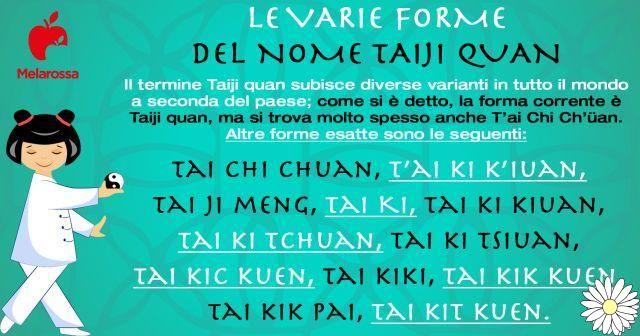
Presentation of tai chi
Tai chi is a martial art that is made up of different practices.
- "Ba duan jin" or the "8 pieces of brocade": this Qi Gong sequence prepares you to practice Taiji. The aim is to open the 3 doors, that is, to unlock the shoulders, waist and hips to facilitate the circulation of energy in the body.
- "Large sequence" or "long form": it consists of 80 or 108 movements (according to the schools) that simulate a fight with an imaginary opponent.
- "Tui Shou" or "Pushing of the hands": these exercises are done in 2. The aim is to be able to feel the other in order to deflect, dodge and control strength.
- "San Shou" or "Dodging hands": it's a 2-player sequence in a continuous game of simulated attacks and defenses.
- "Ping Chi" or "weapons practice": weapons are part of the practice: saber (taiji dao), sword (taiji jian), fan, stick, dagger, etc. Each of them is used following a specific sequence.
How do you spell that
The word taiji or tai chi or t'ai chi has numerous variations all over the world. The most used spelling is taiji or tai chi.
What is the difference between Tai Chi Chuan and Qi Gong
Il tai chi or taiji quan is a form of dynamic Qi Gong which, beyond the health benefits provided by Qi Gong, is a martial art where each movement has a precise combat correspondence.
On the other hand, the history of the creation of taiji Quan explains it, because the founders were inspired by both kungfu wushu techniques than to health techniques (Dao Yin).
Furthermore, the forms and sequences practiced in tai chi are much longer than the sequences used in dynamic Qi Gong.
Finally, this discipline helps to regain inner calm in the outward movement while the Qi Gong helps you find internal movement in the outward calm.
If you are interested in the topic, discover ours in-depth study on QI Gong.
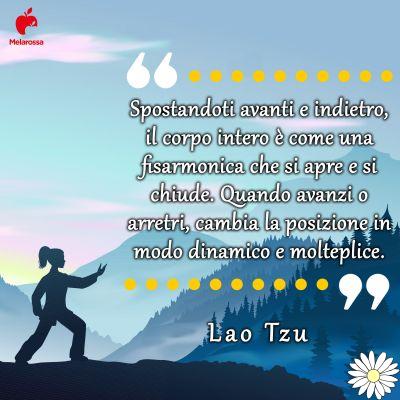
Benefits of tai chi for the body and mind
Tai chi is the way that leads to self-realization, in a constant, progressive and balanced way.
The main foundation of this martial art is of do not use muscle strength. In fact, it is one meditation in motion and the goal is that the body, even if it moves, is always relaxed during the practice.
The coded positions that alternate they help to harmonize the vital energy (Qi) which circulates along the acupuncture meridians. The more you practice, the more relaxation and fluidity of movements help relaxation of muscle tension and you will have a deep feeling of physical and mental relaxation even after the sessions.
Moving slowly helps you boost your inner strength and gives you:
- Tonicity
- Vitality
- Vivacity.
Whatever your age, this discipline it is recommended because it strengthens balance and harmonizes Yin and Yang. Furthermore,
- Improve overall health.
- It increases concentration and helps correct posture.
- Improve memory and balance.
- It amplifies the vital energy and strengthens the nervous system.
- Releases muscle tension and energy blocks.
- Help you sleep better.
Health benefits
Thanks to tendon-muscular work and deep abdominal breathing, the practice leads to a general improvement of your physical condition e physiological. It is for these reasons that the Chinese government has encouraged large-scale practice since the 50s.
Nervous system
Constant practice prevents and improves disorders of the brain and nervous system. Parkinson's diseases, multiple sclerosis, post traumatic stress syndrome, autism, Alzheimer's, etc. they can improve.
Name stress
Furthermore, the benefits also occur on a psychological and mental level. By taking the mind away from everyday worries, the learner focuses on the present moment and movement.
With the practice you can relax mentally both in the gym and after. To maximize the effects, practice at home is also recommended.
Elderly people and tai chi
Practice improves balance and reduces the risk of falls for older people because the movements include elements of:
- Toning.
- Balance.
- Coordination.
- Postural alignment.
- Concentration.
Blood pressure
Uno Harvard studio revealed that people who practice this discipline have lower blood pressure.
Fibromyalgia
Uno recent study proves that the practice of tai chi reduces pain in people with fibromyalgia after 24 weeks of practice.
Discover ours in-depth study on Fibromyalgia.
Rheumatoid arthritis
It reduces some symptoms of rheumatoid arthritis. In China, tai chi is recognized as an effective treatment for rheumatoid arthritis. According to several studies, the practice can improve the range of movements of the legs and particularly of the ankles.
However, it would not have a positive impact on leg swelling.
It's good for the heart
According to a study published in the journal American Heart Association, traditional exercises such as tai chi seem to contribute to the well-being of those suffering from:
- Cardiac pathologies.
- Hypertension.
- Consequences of a cerebral vascular accident.
Chinese prospector Yu Liu and his colleagues completed 35 studies with a total of 2249 participants in 10 countries. They found that patients who practiced tai chi after a heart attack were successful reduce systolic pressure of about 9,12 Hg and the diastolic pressure at 5 mm Hg.
In addition, they showed a modest reduction in percentage of bad cholesterol and triglycerides.
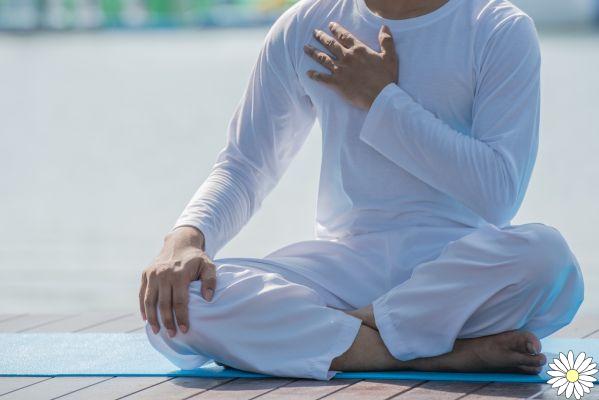
Physical benefits
Il tai chi is also a martial art of defense and combat and each movement corresponds to a martial application. The work of the forms allows at first to develop the qualities necessary for combat such as:
- Stability.
- Agility.
- Musculature.
- Rooting.
- Resistence.
- Precision
- Coordination.
To the next level, tai chi allows you to exercise and control the transmission of IQ in the body. On the other hand, the 2-way technique of "pushing with the hands" (tuishou) allows, in the form of a game and listening to the other, to develop a fighting instinct and to correct your flaws.
Finally, especially for Westerners, with the knowledge and understanding of philosophical concepts, tai chi also offers the key to open the mind and open yourself to change.
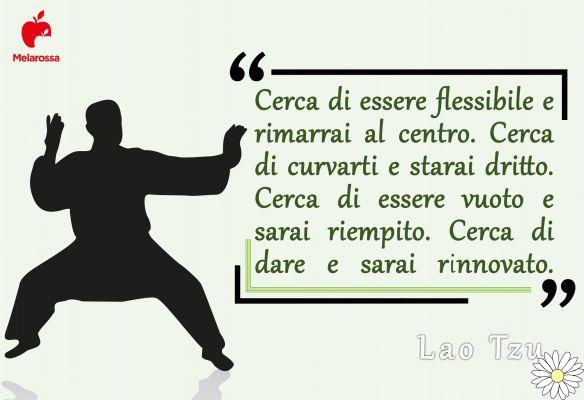
The forms in tai chi
A form, in tai chi, is a sequence of linked movements. The basic form consists of 8 gates (or forms) and five positions for a total of 13 movements.
Le Yang and Chen families have expanded it to reach 108 movements. But in the 40s, Master Cheng sensed that it was complicated to practice these 108 movements and then created the 37-movement form.
Instead, Yang-style tai chi includes specific sequences, one of which became widespread in the twentieth century: the shape of the 24 Beijing positions.
Then, was created by the Chinese Sports Commission in 1956, at the request of the Government, and aimed at spreading tai chi. Form 24 comes from the long form of the Yang style.
However, there are many other forms, depending on the style, some complete and others revisited in a modern key.
The circular shape
The circular form of taiji quan is often described as le hands, wrists and arms which move in elongation but maintain the circularity of the joints.
La circular shape promotes relaxation, elasticity, energy circulation.
On the other hand, the concept of the circle is found in:
- Sequence of steps that brings the last posture back to the starting point, in the idea of a circular movement.
- Every movement of the hand is in fact a movement of life.
This movement favors the distribution of energy in the set of meridians that are found in the canal located at the level of the belt, the That's Mai. Life commands energy by connecting the inside with the outside.
Tai chi masters argue that in this (even imaginary) circle your opponent has less grip because you hide both the starting and ending points and disorient your opponent.
Furthermore, the notion of the circle is related to fluidity and continuity, each movement is performed without interruption. The 3 parts that Yang took as a reference: the sky, the earth and man (in the middle) -TIAN-DI-RIEN - which follow one another without pause.
The movements of taiji reflect man's belonging to universal laws, to the uninterrupted rhythm of life, to the succession of the seasons, to the days, to the flow of rivers until the fulfillment of a single breath, HE: the breath of the heart that makes life long and invulnerable.
Hand movements: 8 doors and the 5 movements
Le 8 gates are the basic movements of tai ji Quan. They are associated with 5 possible displacements.
The result is the form (sequence of 13 postures) that you can find in the different styles.
The 8 gates are the basic movements of tai chi. They are associated with 5 possible movements. The result is the form. Here is the sequence that you can find in the different styles.
- Peng- Parry.
- Li- Retreat.
- Ji- to press.
- An- To push.
- Cai- Pull down.
- Lie- To divide.
- Zhou- Hitting with the elbow.
- Khao- Hitting with the shoulder.
Shifts
- Jin- Step forward.
- Water- Step back.
- Zuo Gu- I'm going to the left.
- You Pan- step to the right.
- Thing- Neutral or starting position.
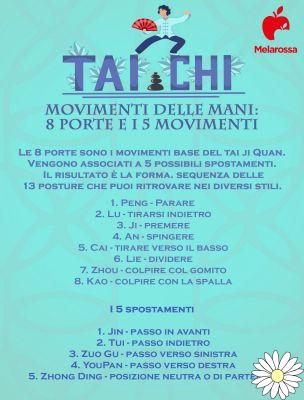
Main leg movements in tai chi
Full: this step is translated as the rider's posture but it is also the horse's posture (ma = horse, bu = posture, step)
Gong bu or position of the archer, is the basis of many postures of tai chi chuan: brushing the knee (Lou Xi Ao Bu) or the Simple Whip (Dan Bien).
Xu Bu: the empty step is a position of defensive withdrawal (weight of the body on the left leg) while the right leg remains "empty". You use it in the following positions:
- Needle at the bottom of the sea (Hai Di Zhen).
- Caress the horse (Gao Tan Ma).
- The White Crane spreads its wings (Bai He Liang Chi).
Pa Bu: the slipped step is so called because it almost goes down to the ground. Use this step, for example, in the position of the snake crawling (Xia shi).
The main positions
Le positions are very numerous and the sequences may vary according to the type of tai chi practiced.
Positions have names that describe the shape. Not only that, many positions are based on nature or animals. Such as “The White Crane Spreads Its Wings (Bai He Liang He)” and “The Hungry Tiger Throws Himself on the Meal” (E hu pu shi). While other positions have names that give a description of the action of the body.
Here are some examples:
- Rotate the body and cut down with the sword (Fan shen xia di jian).
- Separate the grass to look for the snake (Bo cao xun she).
- Brush the knee and twist (Zuǒyòu Lōuxī).
- Stroking the head of the wild horse (Gāo tānmǎ).
Most types of tai chi they begin with a position called preparation e they end with the same position, returning to the starting position or closure.
How a tai chi lesson takes place
Tai chi is not studied in a month. The practice requires perseverance, rigor and diligence. There difficulty for beginners is learning to slow down. In fact, it is the slowness of execution that helps to feel the IQ.
Not only that, the awareness from one leg to the other and the play of alternating arms and legs perfectly embody Chinese thought based on the dynamic balance of Yin and Yang.
During the sequences, are the hands that guide the movements and that intercept the energy and the they transmit to the whole body.
La duration of a lesson is between 1 hour and 1.15. You can take individual or group lessons.
Lessons always start with a warm-up for about 15 minutes to stretch and relax. Exercises help you develop joint mobility and prepare your body for sequences.
Instructions for proper practice
Before practicing, it is essential to understand the correct position well. A good teacher will explain to you how to set up the body.
- Be careful not to have the chin too protruding to avoid a too pronounced curve of the cervical vertebrae of the nape.
- Keep your tongue pointing up to help the saliva descend.
- The shoulders must be relaxed and in perfect symmetry.
- Relaxed chest.
- Try to eliminate the tensions of the spine thinking you are a puppet hanging from a thread, you have to bring the sacrum back as if the thread passed from the top of the head to the crotch of the legs.
- Keep your legs well aligned without bending your knees inward.
Forms or sequences
After yes work on shapes or sequences, I am figures with fluid, continuous and circular movements which are carried out slowly. Some shapes can be done in pairs. The teacher can integrate some elements of Qi gong to rebalance the body posture and channel energy.
The gestures are very slow with deep breathing, and it is for this reason that tai chi is called "meditation in motion".
- displacements facilitate positioning in space, balance, coordination, relaxation, dynamic meditation and centering essential to the practice of tai chi.
Le forms in pairs they are not proposed to face each other but to create the same energy and harmony as Yin and Yang and verify stability and relaxation.
Once the student has all the basic elements for the practice, he can start practicing with weapons:
- Sword
- Folding fan
- Bastone
- Saber.
At the end of the session, they are done stretches and relaxation exercises.
Tai chi as a martial art
Tai chi as an internal martial art insists on developing an agile and dynamic force named Jing.
A of the rules is relaxation (song, song kai) which allows the fluidity of movements and coordination. So a punch is born from the waist, it extends with the shoulder and then the arm. THE muscles are stressed in a coordinated way and the force comes from a quick contraction during impact.
Once the student has succeeded in controlling relaxation, he must seek Peng Jing o internal strength. It consists of connecting each part of the body while remaining relaxed.
Peng Jing is the characteristic force of tai chi: controlling movements by exerting tangential or rotational forces.
Il tai chi develops body grounding with the energy that starts from the "roots" of the feet.
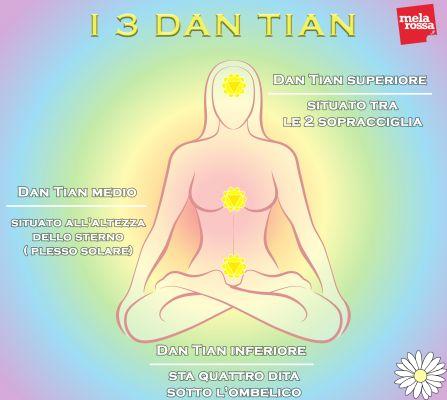
Tai chi: how to train at home
Do you want try tai chi at home? Here are some tips to start the practice.
First, your mind needs to be relaxed. Creating the void is the first exercise of the practice following the "principle of the 3 inner harmonies" of Chinese thought. The search for harmony between:
- Mind and thought
- Inner thought and energy (Qi)
- Qi and inner strength, that is, the strength that comes from Qi.
Achieve inner calm with breathing
To be able to get closer to a state of inner calm, you need to focus on slow, conscious breathing, called abdominal or diaphragmatic breathing.
The advice is to start lying on your back to feel the movements well. Place your hands on your stomach to better feel the alternation of movements that circulate in the lower dantian (tan Tien), a reservoir of energy located 4 fingers below the navel.
Contact with the earth
There are 3 energy centers in the body, they are called Dan Tian:
- Upper, center of the head between the eyebrows
- Middle, solar plexus
- Lower, 4 fingers below the navel.
Focusing on abdominal breathing you get in touch with the energy connected to the earth, intuitive energy. This center is our center of gravity from which our health depends.
Body posture
The body should be straight and ready for action but relaxed. The gaze is connected to mental energy and is coordinated with the movement of the body.
The chest must be relaxed. The coccyx naturally erected thanks to the alignment of the spine. If you tend to arch your back, start with gentle pelvic swing movements to feel the alignment of your spine.
Le shoulders are relaxed so that energy can circulate. The waist, with small rotational movements, moves first, to change direction.
The upper and lower body in tai chi
La upper body is stretched out, the limbs must never be totally stretched. There lower body is anchored but mobile. The knees are very important, they must be soft and never go beyond the tip of the toes.
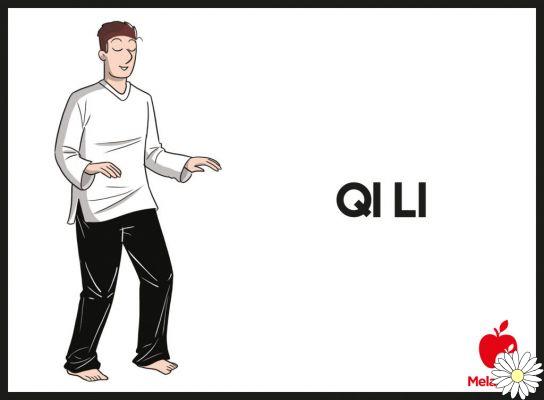
Qi li to find balance
To find balance, do the exercise of Qi li or the initial position of all forms. This position can help you become aware of your breathing and body relaxation to be able to circulate the IQ (vital energy).
How to perform Qi li
The feet are spread apart, with a width that must not exceed that of the shoulders, the weight is well distributed on both feet and the heels adhering to the ground.
It sounds easy but this position is from hold initially for a quarter of an hour and when you have found relaxation and feel all the tensions dissolve, try for half an hour.
Become aware of your body e try to feel if the weight is well distributed: most people, in fact, have an imbalance.
For this simple position you must follow the instructions because, as they say in China:
"A good plant needs good roots to grow first."
Exercise of the imaginary opponent
Although tai chi favors inner strength, it is in any case a 'martial art of defense. The movements developed in theinteraction of partners who face each other. In fact, it is common to practice without a real opponent.
If you want to practice tai chi by yourself at home, you need to focus on:
- Equilibrio
- Fluidity
- Weight shift.
Furthermore, imagine an opponent it can motivate you and give you meaning, like dodging a blow. This imaginary opponent can become your best ally to improve.
Start with the Yang style
When you start practicing any activity, it takes a few sessions to take the measurements. Motivation will help you progress and memorize the exercises. The advice is to start with the Yang style which in addition to being the most famous is also suitable for beginners.
There are different forms in the Yang style: they are sequences with a variable number of 8, 24 or 103 movements.
Start with the Yang form in 8 movements. Watch the video above and try the sequence.
Leitmotiv: slowness, fluidity, breathing.
The positions
- Opening.
- Repel the monkey.
- Brush the knee.
- Divide the horse's mane.
- Hands in the clouds.
- Golden rooster on one paw.
- Heel kick.
- Grab the sparrow by the tail.
- Cross your hands.
- Closure.
Self observation
When you practice alone, no one can correct your postures, changes of direction or coordination, therefore you have to learn to observe yourself.
La repetition of movements is an excellent exercise and being aware of your mistakes is already progress.

Tai chi philosophy
The main currents of thought that have influenced taiji are Taoism and in particular the theory of yin and yang. Indeed, these are the two fundamental poles of the universe and they embody the passive and active qualities of phenomena.
The ""Tao Te King" by Lao Tzu is the founding text of Taoism, the Chinese philosophy born more than 2500 years ago. The Tao Te King is one guide of wisdom where aphorisms and metaphors lead you towards a reflection on yourself but also on the world.
Internal martial arts such as tai chi and Qi Gong are inspired by Taoism.
The philosophical origin of Taoism is attributed to Lao Tzu. The old Chinese master was an archivist at the court of the kings of the Zhou dynasty (-600 BC). He is considered the creator of a philosophy that arises from the antagonism between laws of men and the laws of nature.
However, it is difficult to give an explicit definition of Taoist philosophy because even if very simple at first glance, when you delve into it, it becomes more and more complex.
Taoism: what it is
La translation of Taoism is the way. The meaning of the Chinese ideogram is intelligent movement in the path.
Il Taoism is the doctrine of universal harmony. To reach it, you must follow the Tao, the away to reach the void, which is what offers the spirit lucidity and freedom since the mind is freed from emotions and materialism.
For Taoists - but also for Buddhists - life is a balance between opposites. Each element, each natural event is compensated by an identical but also opposite reaction. Indeed, this balance can become imbalance if one of the factors prevails.
Everything is animated by 2 forces: the yin, negative, passive and fertile and the yang, positive, active but also destructive.
The major component of the feminine nature is regarded as Yin while that of man has a predominance Yang. They feed on each other but are also complementary. The perpetual movement between these polarities is at the origin of the main feature of the world: impermanence (everything is transient, everything changes, nothing is eternal).
Like all Eastern philosophies, the philosophy of the Tao is inspired by observation and contemplation of nature. However, the notion of good and evil is not present in Taoist thought, it is there search for the natural balance that dictates our actions.
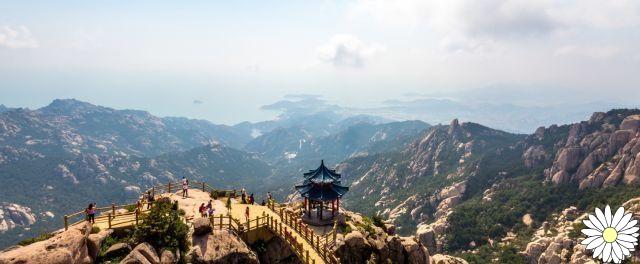
Yin Yang and Tao (at the origin of the Tao)
Creation is the result of 2 complementary forces: Yin and Yang. Existence is a precarious balance of the original Chaos.
In Taoism, there is neither God nor divine representation but a ideal to reach. This ideal consists in do not disturb the Yin Yang balance and in living in harmony with nature and men.
Getting started in the Tao is the way of wisdom
Taoism is the best way to:
- Learn.
- To observe.
- To read.
- Meditate.
“THOSE WHO SPEAK DON'T KNOW AND THOSE WHO KNOW DON'T SPEAK“. LAO TZU
The search for balance
The world is in precarious balance, in a cyclical movement between Yin and Yang. The best way to hear it, according to Lao Tzu, is "to be passionless”, Contain futile emotions e accept the world.
Passion is defined as a state where the emotions and desires manage your way of life. But these emotions, these desires conceal the true nature of things because they induce excesses and consequently lead to one imbalance in the universal natural movement.
The humility to move forward
“The wise man knows himself, but he does not show himself; he has respect for himself, but he does not consider himself precious. " Tao Te King
Learn to marvel
The Taoist sage holds the open eyes to the beauty of the world and gets rid of artificial pleasures.
La beauty is an aid for spiritual pursuit, it is part of the Yin element, feminine and sweet, while on the contrary the truth, which is Yang, is the strong element.
These two components lead you to fully appreciate life and happiness. A legend tells that Confucius, Buddha and Lao tzu were all three in front of a jar of vinegar (which symbolizes life).
Each dipped a finger in the liquid and tasted it. Confucius found it sour, Buddha bitter, and Lao Tzu sweetened.
Wu Wei or non-action
Il Wu Wei is a very important concept of Taoism, Wu Wei would be "non-action ", not in the sense of doing nothing but instead of act only when needed.
For example:
- The sage also teaches in silence.
- Convince yourself by asking questions.
- Internal martial arts such as tai chi use the strength of the other to neutralize it.
Elasticity wins over strength
In this world, there is nothing more malleable than water. However, no living being can resist the action of water (corrosion, wave strength, etc.) and no living being can live without water (drinking, growing, etc.).
The greatest virtue, says Lao Tzu, is like water flowing in low places that others disdain and thus is close to the Tao.
For example, the Taoist empties himself to fill up, it becomes weak as water to win.
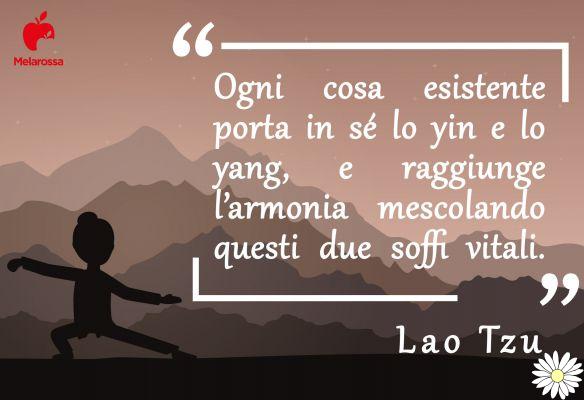
Inner Tao
“Abandon what is outside, says Lao Tzu, cultivate what is inside. Live for your center. "
Yin and Yang
The Yin embodies the passive aspect, the feminine, the darkness, the defense, the interiority. It is also associated with the moon and the color black. Yang embodies the masculine, the action, the light, the outside. It is also associated with the sun and the color white.
The interaction of Yin and Yang is at the origin of the Supreme Polarity and is represented by this very famous design.
This design called "tai chi you”Must be watched in continuous rotation. It symbolizes the cyclical evolution of Nature. In fact, the Yin and Yang elements are not to be regarded as opposite but complementary and interdependent.
In tai chi, the harmony between two opposites has two identical surfaces as a symbol. THE black and white points that are in the opposite color zone indicate that there is always some Yin in the Yang and vice versa.
The teaching is that each element has a Yin component and a Yang component. So the light needs the dark to exist, like the heat of the cold.
In the same spirit, the man has a female part and the woman a male part. Everything resides in the balance to be found.
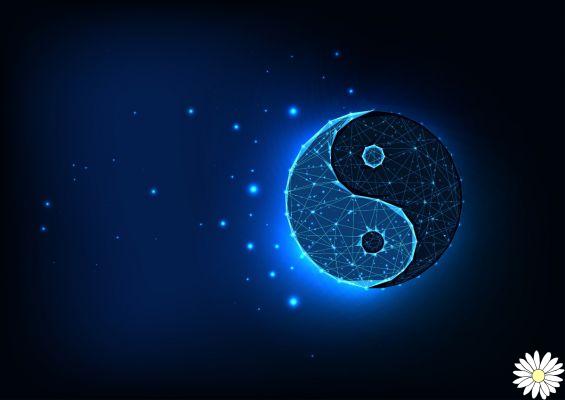
Movement, Yin Yang cycle and IQ
All tai chi movements are circular and during the practice Yin and Yang alternate without interruption. For example, the forward foot is Yang and the back foot is Yin. As soon as you take a step, Yin becomes Yang.
Chi, inner life energy
According to Chinese thought, the Universe is impregnated with a vital energy that makes atoms move, nourishes cells and allows life itself to exist. This energy is called IQ.
La word Qi means "energy" but can also mean "air". It is during breathing that the air gives the body oxygen and IQ. The latter runs through the interior of the organism through its energy channels, the acupuncture meridians, and is stored in the Tan Tien (or Dan Tian) which is the seat of the vital essence.
“By maintaining concentration on the Tan Tien and removing thoughts that divert attention from the mind, you create a center of arousal in the cerebral cortex and gradually strengthen it, simultaneously intensifying the inhibition in other parts of the cortex. This procedure contributes to the formation of a sort of protective inhibition which is of great therapeutic value. " Cen Yuefang, The fundamentals of Qigong
With the practice of Qi Gong, tai chi and associated breathing, you can conserve QI, the life energy.
This energy can be used to:
- Heal local, joint and muscle pains.
- Reduce Stress.
- Relieve pain.
- Find elasticity.
- Improve physical and emotional balance.
- Be healthy.
- Dodging or accepting physical or emotional shock.
In the human body, the Qi circulates through the meridians. It is possible to activate it, guide it and circulate it in the body with the power of thought and obtain extraordinary results.
How to activate the inner energy
Qi Gong
Qi Gong is a gentle and slow exercise which comes from traditional Chinese medicine. The principle of Qi Gong is to be able to control the Qi with the body, and regular practice would help also activate the body's self-healing process.
The Chinese government in the 80s created the National Qigong Science and Research Organization to have a check on the practice. In the faculties of Chinese medicine they teach the techniques of Qi Gong.
Since 1996, theChinese Qi Gong Association and Qi Gong has become an integral part of Chinese national health policy.
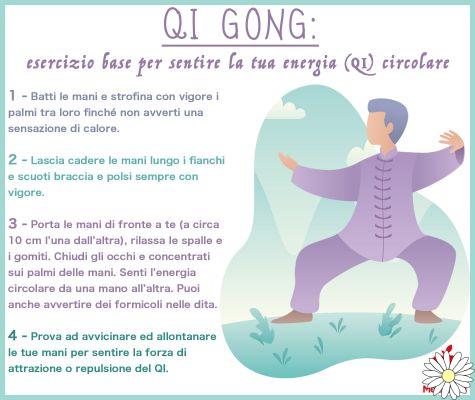
QI Gong: basic exercise to feel your circular energy
- Clap your hands and rub your palms vigorously together until you feel a sensation of warmth.
- Let your hands fall to your sides and always shake your arms and wrists vigorously.
- Bring your hands in front of you (about 10 cm from each other), relax your shoulders and elbows. You close your eyes and focus on your palms. Feel the energy flowing from hand to hand. You may also feel tingling in your fingers.
- Try moving your hands closer and apart to feel the pull and repulsion of the IQ.
Abdominal breathing
To practice tai chi correctly, you must learn to circulate the Qi up to the Tan Tien.
Tan Tien is one of the gateways to energy. It is located 4 fingers below the navel and one third of the distance between the abdominal wall and the spine.
The inhaled air must reach the center of gravity of the body with diaphragmatic breathing, also called abdominal breathing.
Learning to feel the energy stored in the Tan Tien is a fundamental basis in the practice of internal martial arts. Tan Tien is also called the psychophysical center.

The great Qi revolution
In the respiratory cycle you have to visualize that the Qi, after reaching the Tan Tien, during the exhalation it goes up along the vertebral column up to the top of the head for come out of the nose or mouth.
For example, if you perform an exercise with the upper limbs, such as pushing the hands forward, guide the flow of Qi towards the spine and you will feel an energy wave starting from the arms to the palms of the hands.
Those who practice taiji and Qi Gong become aware of the energy flow that runs through the whole body.
And there is the difference between a mechanical movement that starts from the arm but which in the end has little power and a movement that uses energy and therefore enhances strength.
The other two vital energies: Ching and Shen
According to Chinese thought, two other forms of energy coexist in the universe.
Ching: the essence of life
Ching is the vital energy that offers the body:
- Physical force.
- Capacity for development, growth, reproduction and aging.
La tradition holds that it is important not to waste energy but cultivate it to avoid disease and live longer. The way is moderation, that is, avoiding excesses. Follow a healthy diet and practice psychophysical exercises.
Shen: spiritual energy
Shen is the most refined form of energy. Allows you to reach a intense mental concentration and increases the power of thought. In fact, it stimulates the Qi and makes the movements fast and concentrated.
Furthermore, lShen energy allows you to become aware of every part of the body. Stimulates the flow of Qi.
The purpose of tai chi and qi gong it is not only to be able to accumulate the three energies but also to purify and transform them.
In fact, with a lot of practice, it is possible transform Ching into Qi and Qi into Shen to sharpen Shen into Hsu, the mental emptiness, that is higher meditative state, also called Nirvana.
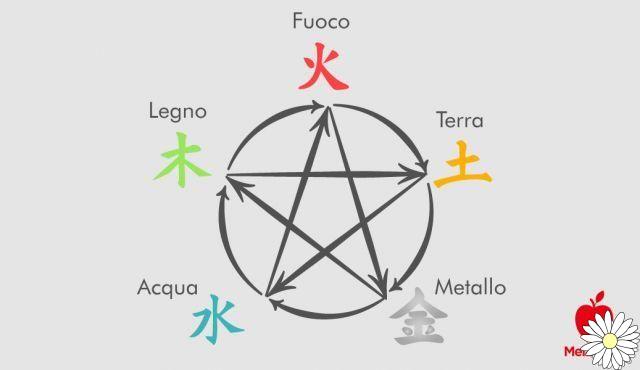
The 5 Elements Theory in Chinese Medicine
The 5 element theory represents the very foundation of Chinese medicine and enriches the theory of Yin and Yang. These elements are: water, wood, fire, earth and metal.
In the practice of internal martial arts such as tai chi, knowledge of the elements reinforces the coherence between the inside and the outside and it constitutes a higher level in the understanding of the natural cycle of things in Taoist philosophy. This higher level of knowledge enhances the practice: Qi Gong, tai chi, etc.
According to Chinese practice, these 5 elements are 5 potential for change present in every phenomenon.
5 elements: what they represent
Wood: expansion, outward movement.
Metal: compression, inward movement.
Acqua: downward movement.
Fire: upward movement.
Terra: neutrality, stability.
The 5 elements and the seasons
A season for each element:
Wood: spring associated with birth.
Fire: summer associated with growth.
Metal: autumn associated with the harvest.
Acqua: winter associated with conservation.
For the earth it is a little different because it corresponds to the end of a season associated with transformation. The energies of the sky return to the earth to reconstitute themselves during the changes of seasons: therefore each change of season is under the influence of the Earth element.
The 5 elements and the 5 organs
Wood: corresponds to the liver and pancreas.
Fire: to the heart and small intestine.
Terra: corresponds to the stomach and spleen.
Metal: to the lungs and large intestine.
Acqua: corresponds to the kidneys and bladder.
Cyclical interaction between the 5 elements
To understand the laws that govern nature, according to traditional Chinese medicine, it is important understand their interaction. The nature of each interaction brings elements of understanding of the symptoms.
Similarly, i symptoms of a disease highlight the elements whose strength is at work. Each element is generated but also generates. So the water generates the wood that generates the fire that generates the earth that generates the metal that generates the water.
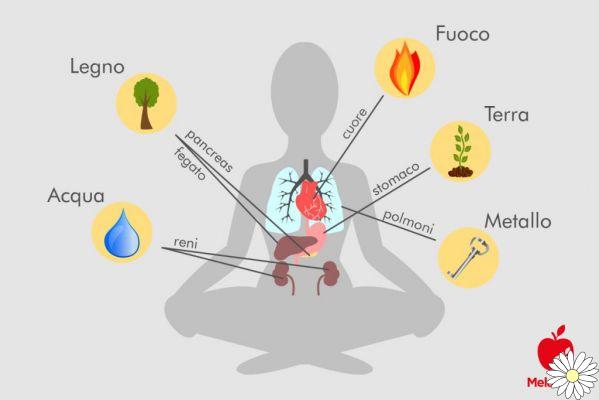
The fundamentals of tai chi: 10 basic principles
Whether it's the Wen or Yang style, all masters insist on respect for the 10 fundamental principles of taichi. Yang Cheng Fu (1883-1936) was a martial arts master. He wrote the ten principles to make people understand in a simple way how to practice tai chi.
Here is a summary.
1- Light head and alert mind
The head is suspended from a thread. There must be no stiffness in the neck. The head must be in line with the spine. While the mind awake means be listening to what's going on in your body instead of being focused on the gesture.
So, when practicing, you don't have to focus on hands, feet, etc. nor judge the gesture whether well done or not. Let the thoughts come to mind and try to live the gesture.
2- Relaxed chest and straight back
Avoid bringing your chest forward because you risk contracting your back. Keep your back straight and your chest relaxed to better connect both your back and arms.
This also helps you better coordinate your chest and waist. So, circulate the energy in the belly, in the Tan Tien, and you have a feeling of relaxation.
3- The waist (Yao), the pelvis: center of movement
Il pelvis is the master of the whole body. If you can relax the pelvis (lumbar), the two feet on the ground will have more strength and power, you will feel grounded and your body will be stable.
Not only that, the waist is the part of the body where the lower Tan Tien is located which is where the energy resides. If the waist and pelvis are contracted, energy hardly passes to other areas of the body.
On the other hand, if you relax your waist and pelvis, energy circulates throughout the body.
4- Alternation of full and empty
The distinction between full and empty is a fundamental principle of taiji.
For example, if your body weight is on your right leg then your right foot is "full" while your left foot is empty or relaxed but it also supports your body weight. In Tai Chi it is all a game of alternating between empty and full.
If you can understand this concept, perform i more easily circular movements and the movements are lighter and above all you save energy when not needed.
On the other hand, if you do not distinguish, the movement of the body becomes passive and heavy and the position of the body is unstable.

5- Relax shoulders and elbows
If you are unable to relax your shoulders, this it prevents your body from developing power and circulating energy freely.
Those with raised shoulders have an agitated mind and high breathing.
But being able to relax them takes time because it is a long process to assimilate and requires you to first reconsider your way of seeing. Indeed, the most important part of the body it is not the head but the pelvis.
You must try to focus attention on the lower Tan Tien for the upper part to relax.
Also elbows must be relaxed to prevent your shoulders from lifting.
If your body can understand this, you will have a wider breath, the exercises will be performed better and eventually the energy will circulate throughout the body.
6- Use will (Yi) and not force (Li)
In tai chi the force that comes from a muscle contraction is not used but on the contrary yes seek muscle relaxation because any contraction hinders the movement.
All the body must be relaxed but alert to be light and agile. In fact, you can achieve power without muscle strength because the meridians and blood vessels are not blocked by stiffness and in that way energy circulates.
Attention, it is not about being soft: taiji is not a relaxation, you use the "Force of the Whip" with thought and elasticity. It is for this reason that we speak of inner strength.
By dint of training, concentration, to experience the relaxation of the body, get true energy potency (JING).
7- Synchrony and harmony of movements
The energy path:
- It spreads in the feet.
- It continues in the legs.
- It is controlled and commanded by the pelvis.
- It blooms in the hands and fingers.
When the hands are put into action, the pelvis moves, the feet move and the gaze follows the movement as well. If a part of the body does not move, there will be disorder. If one part remains stationary the others will also stop.
In a movement, all the parts must be connected to each other and take action at the same time. Joining the upper body (arms) and the lower body is a decisive step.
If you try to do it with your mind, you will never succeed. It is impossible because the conscious control of a gesture concerns only one gesture at a time. Instead, try to connect the movement of the arms to that of the waist-pelvis together, then connect the legs with the waist. That way, you move your waist to coordinate your hands and feet.
8- Union of mind and body
The mind is the commander and the body the emissary.
In fact, it is the mind (Yi) which directs energy (Chi) in the physical body to be manifested externally.
In the practice of tai chi you must strive to always be present and listen to the sensations of your body. It is a very important principle that goes beyond the beauty of the gesture.
Initially, being aware of your body can be difficult until it becomes a new way of life that will also teach you to live the present moment more intensely.
9- Continuity
I movements follow one another without interruption. The end of one action is the beginning of the next. Everything is connected: it is the continuity of the mind and of the circulation of energy in the evolution of actions.
The gesture seems to be suspended in the hands as it continues in life. The minimum suspension time between the two gestures is the moment when the pelvis changes trajectory.
Every gesture, every movement must be done as if you were pulling a silk thread: any sudden movement tears the thread and ruins everything.
Continuity is only possible on sequences that you know well.
10- Search for calm in movement
This seeking calm and peace, but also of harmony in the execution helps you to control the movements well. Not only that, staying calm allows you to have one deep and quiet abdominal breathing.
In fact, chest breathing activates emotions and thoughts while abdominal breathing calms them.
This pursuit of calm favors self-control and creates favorable conditions for the circulation of blood and energy.
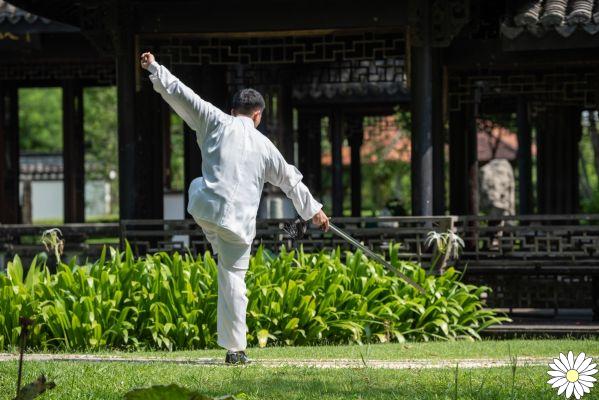
Different styles of tai chi
There are 5 the most popular styles, they all have the names of the families of their creators.
5 styles of tai chi
1 – Yang
Yang style is the most popular in the world. It favors wide, soft but slow movements with low positions that facilitate stability. However, it is quite static.
Suitable for beginners, seniors, and to those looking for relaxation or a moving meditation technique.
2 – Chen
The Chen style is the oldest. This style is more mobile and therefore more physically demanding. He has changes of pace and very low positions that put a lot of strain on his legs. The positions are very wide and a lot of work is done onopening and closing of the body.
Suitable for young people and to those who seek the martial aspect in tai chi.
3 – Wu
The Wu style derives from the Yang style but torso twists have been introduced. The displacements are large and work on the central balance.
Suitable for those looking to work on elongation.
4 – Wu'Lo
The Wu'Lo style is quite difficult to perform. It is hardly practiced in Europe. The movements are small and work mainly on the circulation of energy (Qi) with movements that have many changes of direction. This style makes clever use of the body levers. Many ancient texts come from this family.
5 – Sun
Last born, the Sun style has large and fluid movements with displacements back and forth. Develop great mobility and lightness.
Suitable for anyone who has one good knowledge of tai chi.
What a style to practice
There is no one style better than another. For a beginner, here are some tips according to your goals. Self you are looking for a recreational or gymnastic activity, Yang style can be a great choice to start.
Instead, i Chen style is the one recommended for you if you are interested in both the physical and mental benefits but also the martial aspect of tai chi.
In any case, the advice is to try different styles to find the one that suits you best.
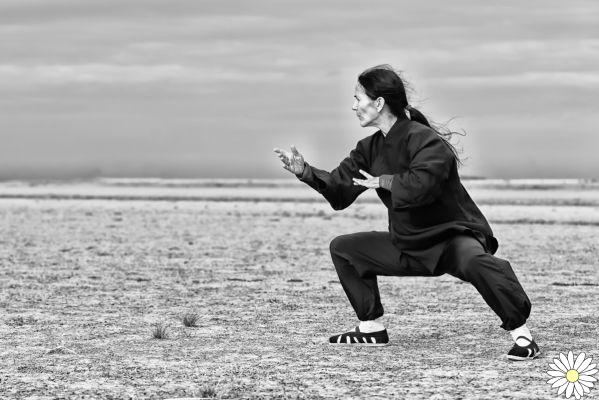
La storia del tai chui cuan
Taichi is an ancestral art which in 600 BC was evoked in the Lao-Tzu's philosophical texts (Laozi), founding father of Taoism.
But according to a legend, the founder of taiji would be a Taoist monk, martial arts expert, Zhang Sanfeng.
Legend has it that one day, Zhang witnessed a fight between a crane and a snake. The snake dodged the bird's blows with harmonious movements, slow but incessant and then counterattack with extreme speed. This demonstration made him understand that, in combat, i movements circular and constant violent movements with straight blows.
Not only that, in his art, Zhang also integrated theagility and flexibility as concepts, because these qualities are superior, according to him, to strength. Lao-Tzu had already understood this and integrated it into his philosophy. Instead, Zhang Sanfeng applied it in martial arts. And that's how tai chi was born.
Throughout history, this discipline is divided into several schools and each has its own style which represents the philosophy of the teacher.
Chen Wang Ting (1600-1680)
For many historians, Chen Wang is regarded as the forerunner of tai chi. General Chen Wang Ting was a martial arts expert and taught his family and Chen villagers exercises inspired by Taoist philosophy.
For five generations, these combat exercises were broadcast only to the members of the village and the techniques remained secret. In those days, there was a single style which was called Chang Quan (long punch). It is only in the nineteenth century that Tai Chi comes out of the Chen clan.
Yang Lu Chan (1799-1872)
Until this period, the tai chi was taught only to a few favorites who was part of the Chen family. They did not accept any foreigners in the village school.
But it was the family Yang at the origin of democratization of this art.
Yang Lu Chan, a native of Hebei Province, was hired as a waiter by Master Chen to spy on the lessons every day. After that, Yang Lu did he trained at night and repeated the movements and the technique he had seen in class.
But one day, the teacher found out while he was training and Yang showed him what he had learned. Yang Lu managed to impress the teacher with his skill and the teacher gave him permission to follow the lessons. In a short time, he became the most gifted pupil.
After a few years, he left for Beijing to open a public school. Not only, he also taught tai chi to the imperial guards. So it is thanks to him that tai chi has spread.
Married, Yang Lu had two sons, Yang Pan Hou and Yang Chien Hou and there educated according to the principles of tai chi chuan. Growing up, the second son had a son: Yang Cheng Fu, who still is today considered the great master of tai chi.
He taught the discipline in the parks and the presented as a sequence of physical exercises. Not only, invented exercises for all ages and a sequence shorter than the initial form (85 movements).
In fact, the traditional form has 108 movements. In addition, Master Yang created the ten principles of tai chi. Even today, it is Yang style is the most popular in the world.
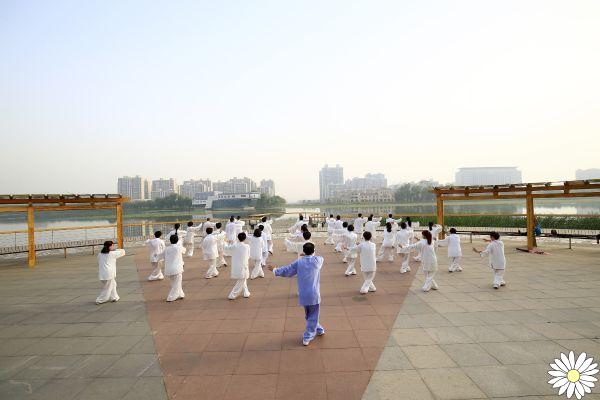
Tai chi from the 50s to today
La version of the Tai chi that the Beijing government has been promoting since the 50s it is called form 24 (there are 24 movements) and it is a very simplified version of the Yang style.
This form freed itself from all technical difficulties and lost martial content because it wants to be first of all one gymnastics practice dessert accessible to all. In universities, coaches are trained who teach tai chi to everyone for free in the parks.
After the ban on the practice of martial arts during the Cultural Revolution, Deng Xiao Ping fostered the Chinese passion for traditional body practices (such as Qi Gong). Moreover, with the opening of the borders it offered the possibility for foreigners to come to China to see the origins of this discipline which had begun to take hold in the West.
It happened during this period also the beginning of the Chinese nationalist awakening and the government undertook to promote, both in China and in the West, the traditional arts of tai chi.
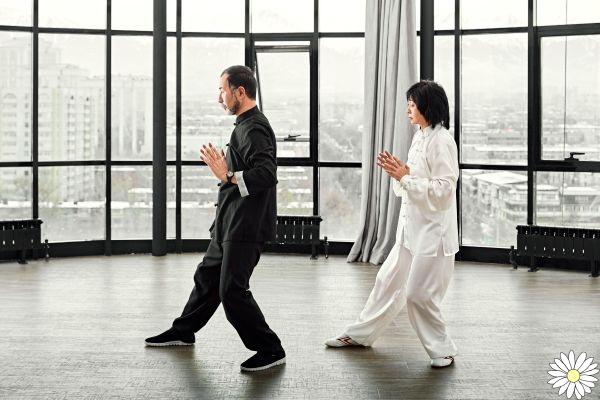
How to dress for tai chi
It can be practiced in the hall or outside in the parks. If you decide to practice it outside, you must obviously take the season into account. In any case, loose, soft and cotton clothes are the most suitable.
For training, you can bring whatever you want, comfortable pants and sweatshirt and a pair of flat shoes. There simpler uniform it's a jogging pants and a t-shirt.
Instead I'm from avoid heavy and stiff clothes like jackets and jeans because they prevent movement during forms and meditation. The most common colors are the black and white.
Even if there isn't a rule, it is better to avoid too bright colors because they could disturb the concentration of others, especially beginners.
What shoes to wear
In tai chi, thefoot support is essential, what shoes to wear?
Flat, soft shoes are recommended for balance and grip on the ground. Some teachers insist that their pupils wear low-soled shoes.
instead they advise against training on foot naked because the sole of the foot must be protected from blows and cold as, according to Chinese medicine, there are many reflexology points that are the key to health.
Here are some suggestions for practicing Tai chi:
1 - SurePromise Kung Fu Shoes
 Anti-slip cotton slippers for martial arts ...
Anti-slip cotton slippers for martial arts ... - Made especially for indoor training.
- Multiple seams on the sole.
- Fully lined padding.
2 - Andux Men Women Tai Chi
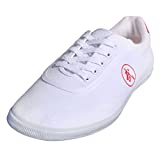 Andux Men Women Tai Chi Martial Arts Shoes ...
Andux Men Women Tai Chi Martial Arts Shoes ... - Material: canvas
- Size: Please refer to the size chart on the detail page to purchase
- The sole is very soft
3 - Sport Shoes TJX-01
 Andux Men Women Tai Chi Martial Arts Shoes ...
Andux Men Women Tai Chi Martial Arts Shoes ... - Upper cloth, sole, cotton lining.
- Comfortable, resistant, durable, flexible product.
- The best choice for martial arts, Kung Fu, Tai Chi, Hip Hop, Parkour, Rock, Wushu and other fashions ...
4 - Uniform for practicing
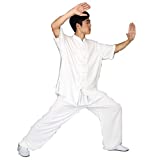 GEGEQUNAERYA Tai Chi clothing morning ...
GEGEQUNAERYA Tai Chi clothing morning ... - 1. Fabric: silky cotton and silk, soft, smooth, breathable.
- 2. Tai Chi Shi Clothing: Tai Chi is a kind of kung fu. Zhang Sanfeng in ancient China has ...
- 3. The most environmentally friendly and original: Chinese worm silk and cotton fabric, as a fabric source ...
Tai chi: contraindications
Tai chi is one practice accessible and recommended to all.
However, if you have severe joint or heart problems or are pregnant, talk to your doctor first.


























